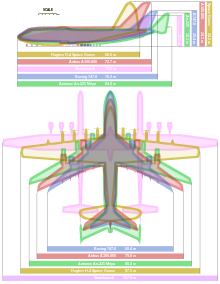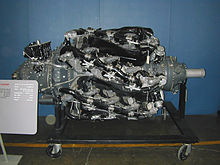From Wikipedia, the free encyclopedia
| H-4 Hercules "Spruce Goose" | |
|---|---|
| Role | Heavy transport flying boat |
| Manufacturer | Hughes Aircraft |
| First flight | November 2, 1947 |
| Produced | 1947 |
| Number built | 1 |
| Career | |
| Other name(s) | "Spruce Goose" |
| Registration | NX37602 |
| First flight | November 2, 1947 |
| Flights | 1 |
| Preserved at | Evergreen Aviation Museum |
Contents |
Design and development

Size comparison between the H-4 and a Douglas DC-3.
The aircraft was the brainchild of Henry J. Kaiser, a leading Liberty ship builder. He teamed with aircraft designer Howard Hughes to create what would become the largest aircraft built at that time. It was designed to be capable of carrying 750 fully equipped troops or one M4 Sherman tank.[3] The original designation "HK-1" reflected the Hughes and Kaiser collaboration.[4]
The HK-1 contract was issued in 1942 as a development contract[5] and called for three aircraft to be constructed under a two-year deadline in order to be available for the war effort.[6] Seven configurations were considered including twin-hull and single-hull designs with combinations of four, six, and eight wing-mounted engines.[7] The final design chosen was a behemoth, eclipsing any large transport then built.[5][8] [N 1] To conserve metal, it would be built mostly of wood (its elevators and rudder were fabric covered[9]); hence, the "Spruce Goose" moniker tagged on the aircraft by the media. It was also referred to as the Flying Lumberyard by critics. Hughes himself detested the nickname "Spruce Goose".[10]
While Kaiser had originated the "flying cargo ship" concept, he did not have an aeronautical background and deferred to Hughes and his designer, Glenn Odekirk.[8] Development dragged on, which frustrated Kaiser, who blamed delays partly on restrictions placed for the acquisition of strategic materials such as aluminum, but also placed part of the blame on Hughes' insistence on "perfection."[11] Although construction of the first HK-1 took place 16 months after the receipt of the development contract, Kaiser withdrew from the project.[10]
Hughes continued the program on his own under the designation "H-4 Hercules",[N 2] signing a new government contract that now limited production to one example. Work proceeded slowly, with the result that the H-4 was not completed until well after the war was over. It was built by the Hughes Aircraft Company at Hughes Airport, location of present day Playa del Rey, Los Angeles, California, employing the plywood-and-resin "Duramold" process[12] [N 3] – a form of composite technology – for the laminated wood construction, which was considered a technological tour de force.[4] It was shipped on streets to Pier E in Long Beach, California by a company specializing in house moving. The Spruce Goose was moved in three large sections consisting of the fuselage and each wing, and a fourth smaller shipment containing the tail assembly parts and other smaller assemblies. After final assembly a hangar was erected around the flying boat with a ramp to launch the H-4 into the harbor. This building became the first climate-controlled building in the United States.
In 1947, Howard Hughes was called to testify before the Senate War Investigating Committee over the usage of government funds for the aircraft.
During a Senate hearing on August 6, 1947 (the first of a series of appearances), Hughes said:
The Hercules was a monumental undertaking. It is the largest aircraft ever built. It is over five stories tall with a wingspan longer than a football field. That's more than a city block. Now, I put the sweat of my life into this thing. I have my reputation all rolled up in it and I have stated several times that if it's a failure, I'll probably leave this country and never come back. And I mean it.[13] [N 4]
Operational history
During a break in the Senate hearings, Hughes returned to California to run taxi tests on the H-4.[9] On November 2, 1947, the taxi tests began with Hughes at the controls. His crew included Dave Grant as co-pilot, two flight engineers, Don Smith and Joe Petrali, 16 mechanics, and two other flight crew. In addition, the H-4 carried seven invited guests from the press corps and an additional seven industry representatives. Thirty-six were on board.[14]After the first two taxi runs, four reporters left to file stories, but the remaining press stayed for the final test run of the day.[15] After picking up speed on the channel facing Cabrillo Beach, the Hercules lifted off, remaining airborne at 70 ft (21 m) off the water and a speed of 135 miles per hour (217 km/h) for around a mile (1.6 km).[16] At this altitude, the aircraft still experienced ground effect.[17] Having proven to his detractors that Hughes' (by now unneeded) masterpiece was flight-worthy, thus vindicating the use of government funds,[18] the "Spruce Goose" never flew again. Its lifting capacity and ceiling were never tested. A full-time crew of 300 workers, all sworn to secrecy, maintained the aircraft in flying condition in a climate-controlled hangar. The crew was reduced to 50 workers in 1962, and then disbanded after Hughes' death in 1976.[19]
Display

Hercules at Evergreen Aviation Museum
By the mid-1990s, the former Hughes Aircraft hangars at Hughes Airport, including the one that held the Hercules, were converted into sound stages. Scenes from movies such as Titanic, What Women Want and End of Days have been filmed in the 315,000 square foot (29,000 m²) aircraft hangar where Howard Hughes created the flying boat. The hangar will be preserved as a structure eligible for listing in the National Register of Historic Buildings in what is today the large light industry and housing development Playa Vista in suburban Los Angeles.[20]
Specifications (H-4)
Performance specifications are projected.General characteristics
- Crew: 3
- Length: 218 ft 8 in (66.65 m)
- Wingspan: 320 ft 11 in (97.54 m)
- Height: 79 ft 4 in (24.18 m)
- Fuselage height: 30 ft (9.1 m)
- Loaded weight: 400,000 lb (180,000 kg)
- Powerplant: 8 × Pratt & Whitney R-4360 Wasp Major radial engines, 4,000 hp (2,640 kW) each
- Propellers: four-bladed Hamilton Standard, prop, 1 per engine
- Propeller diameter: 17 ft 2 in (5.23 m)
- Cruise speed: 250 mph (407.98 km/h)
- Range: 3,000 mi (4,800 km)
- Service ceiling: 20,900 ft (6,370 m)
Notable appearances in media
In the 1988 biopic Tucker: The Man and His Dream, a pivotal meeting between automaker Preston Tucker and Howard Hughes takes place in front of the Hercules, within its hangar, where Hughes briefly tells Tucker that whether the Hercules flies is not the point, as well as how to circumvent the "establishment" and Senator Ferguson.The 1987 animated feature Yogi Bear and the Magical Flight of the Spruce Goose features the Hercules prominently. In the 1991 adventure film The Rocketeer, hero Cliff Secord uses a large-scale model of the Hercules to escape some eager federal agents and Howard Hughes himself. After Secord glides the model to safety, Hughes expresses relief that the craft might actually fly.[21]
The Spruce Goose also played a minor role in the 2000 fictional flight simulator Crimson Skies (video game) by Microsoft.
The construction and flight of the Hercules was featured in the Hughes 2004 biopic The Aviator. Motion control and remote control models, as well as partial interiors and exteriors of the aircraft, were reproduced for this scene. The motion-control Hercules used for the film is on display at the Evergreen Aviation Museum, next to the real Hercules.
In the videogame, L.A. Noire (2011), the player is able to enter the aircraft. Additionally, exterior and interior views of the H-4 Hercules aircraft are featured in the opening introduction of the DLC mission, "Nicholson Electroplating".[22][23]

A size comparison between four of the largest aircraft:
Hughes H-4 Hercules (1947)
An-225 (first flight 1988)
Airbus A380-800 (first flight 2005)
Boeing 747-8 (first flight 2010)
See also
- Aircraft of comparable role, configuration and era
- Related lists
References
Notes
- ^ Quote: "Kaiser announces the most monumental program in the history of aviation."
- ^ The Hughes design was initially identified as the HFB-1 to signify "Hughes Flying Boat, First Design."[9]
- ^ The Hughes Corporation had utilized the duramold process which laminated plywood and resin into a lightweight but strong building material that could be shaped.
- ^ Hughes' Senate Hearings testimony is now in the public domain.
Citations
- ^ "Hughes HK-1 (H-4) 'Spruce Goose'." The Aviation Zone. Retrieved October 6, 2010.
- ^ "Spruce Goose." Evergreen Aviation Museum. Retrieved December 14, 2011.
- ^ McDonald 1981, p. 41.
- ^ a b Odekirk 1982, p. II.
- ^ a b McDonald 1981, p. 45.
- ^ Odekirk 1982, p. 1V.
- ^ McDonald 1981, pp. 41–44.
- ^ a b McDonald 1981, p. 40.
- ^ a b c Winchester 2005, p. 113.
- ^ a b McDonald 1981, pp. 58–59.
- ^ McDonald 1981, p. 56.
- ^ Winchester 2005, p. 113.
- ^ The Great Aviator: Howard Hughes, His Life, Loves & Films — A Documentary. Los Angeles: Delta Entertainment Corporation, 2004.
- ^ McDonald 1981, pp. 78–79.
- ^ McDonald 1981, pp. 85–87.
- ^ Francillon 1990, pp. 100, 102.
- ^ "Wing In Ground effect aerodynamics." se-technology.com. Retrieved: October 6, 2010.
- ^ "Howard Hughes & The Spruce Goose." Life, October 27, 2009. Retrieved: August 28, 2011.
- ^ Dean, Paul. "The Man Who Keeps The Spruce Goose." Los Angeles Times, April 21, 1983, p. J1.
- ^ Freeman, Paul. "Hughes Airport." Abandoned & Little-Known Airfields: California, Western Los Angeles area, October 10, 2012.
- ^ David 1991
- ^ "New L.A. Noire Screens from the "Nichsolson Electroplating" Arson Case." rockstargames.com. Retrieved: September 15, 2011.
- ^ Davison, Pete. "L.A. Noire Nicholson Electroplating DLC out now." gamepro.com, June 22, 2011. Retrieved: August 20, 2011.
Bibliography
- David, Peter. The Rocketeer: The Official Movie Adaptation. Burbank, California: W D Publications Inc., 1991. ISBN 1-5685-190-4.
- Francillon, René J. McDonnell Douglas Aircraft since 1920: Volume II. Annapolis, Maryland: Naval Institute Press, 1990. ISBN 1-55750-550-0.
- McDonald, John J. Howard Hughes and the Spruce Goose. Blue Ridge Summit, Pennsylvania: Tab Books Inc., 1981. ISBN 0-8306-2320-5.
- Odekirk, Glenn E. Spruce Goose (Title inside cover: HK-1 Hercules: A Pictorial History of the Fantastic Hughes Flying Boat). Long Beach, California: Glenn E. Odekirk and Frank Alcantr, Inc., 1982. No ISBN.
- Schwartz, Milton L.The Spruce Goose Commemorative Pictorial. Oakland, California: The Wrather Corporation by Mike Roberts Color Productions, 1983.
- Winchester, Jim. "Hughes H-4 'Spruce Goose'." Concept Aircraft: Prototypes, X-Planes and Experimental Aircraft. Kent, UK: Grange Books plc., 2005. ISBN 978-1-59223-480-6.
- Yenne, Bill. Seaplanes & Flying Boats: A Timeless Collection from Aviation's Golden Age. New York: BCL Press, 2003. ISBN 1-932302-03-4.
External links
| Wikimedia Commons has media related to: Hughes H-4 Hercules |
- Evergreen Aviation Museum, McMinnville, Oregon, home of the Spruce Goose
- "Tomorrow With Tom Snyder" show on the Spruce Goose from 1979
- Spruce Goose: Where Is It Now? A history of the aircraft following Hughes' death
- The Aviator (2004) Biography/drama movie about Howard Hughes with H-4 Hercules Spruce Goose episode
- Howard Hughes' Sikorsky at Brazoria County Airport, Texas
- "World's Largest Airplane Takes To The Road", Popular Science, August 1946,
- "Look Inside The World's Largest Plane", Popular Science, September 1945
- 200 tons and it flies! article January 1948 Popular Mechanics
- Howard Hughes & The Spruce Goose - slideshow by Life magazine
- A film clip Cruiser Bow Ripped Off By Typhoon, July 23, 1945 is available for free download at the Internet Archive



Tidak ada komentar:
Posting Komentar